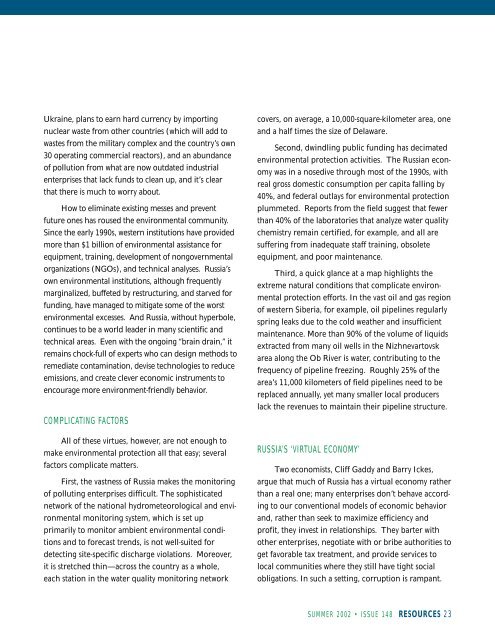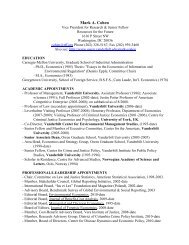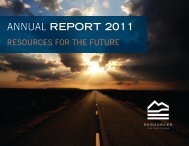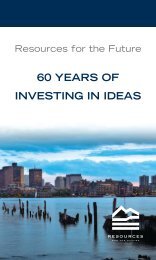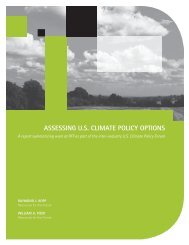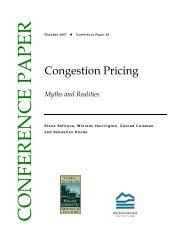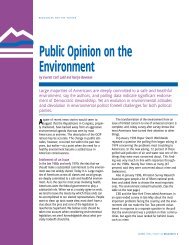Resources: Summer 2002; Issue 148 - Resources for the Future
Resources: Summer 2002; Issue 148 - Resources for the Future
Resources: Summer 2002; Issue 148 - Resources for the Future
You also want an ePaper? Increase the reach of your titles
YUMPU automatically turns print PDFs into web optimized ePapers that Google loves.
Ukraine, plans to earn hard currency by importing<br />
nuclear waste from o<strong>the</strong>r countries (which will add to<br />
wastes from <strong>the</strong> military complex and <strong>the</strong> country’s own<br />
30 operating commercial reactors), and an abundance<br />
of pollution from what are now outdated industrial<br />
enterprises that lack funds to clean up, and it’s clear<br />
that <strong>the</strong>re is much to worry about.<br />
How to eliminate existing messes and prevent<br />
future ones has roused <strong>the</strong> environmental community.<br />
Since <strong>the</strong> early 1990s, western institutions have provided<br />
more than $1 billion of environmental assistance <strong>for</strong><br />
equipment, training, development of nongovernmental<br />
organizations (NGOs), and technical analyses. Russia’s<br />
own environmental institutions, although frequently<br />
marginalized, buffeted by restructuring, and starved <strong>for</strong><br />
funding, have managed to mitigate some of <strong>the</strong> worst<br />
environmental excesses. And Russia, without hyperbole,<br />
continues to be a world leader in many scientific and<br />
technical areas. Even with <strong>the</strong> ongoing “brain drain,” it<br />
remains chock-full of experts who can design methods to<br />
remediate contamination, devise technologies to reduce<br />
emissions, and create clever economic instruments to<br />
encourage more environment-friendly behavior.<br />
COMPLICATING FACTORS<br />
All of <strong>the</strong>se virtues, however, are not enough to<br />
make environmental protection all that easy; several<br />
factors complicate matters.<br />
First, <strong>the</strong> vastness of Russia makes <strong>the</strong> monitoring<br />
of polluting enterprises difficult. The sophisticated<br />
network of <strong>the</strong> national hydrometeorological and environmental<br />
monitoring system, which is set up<br />
primarily to monitor ambient environmental conditions<br />
and to <strong>for</strong>ecast trends, is not well-suited <strong>for</strong><br />
detecting site-specific discharge violations. Moreover,<br />
it is stretched thin—across <strong>the</strong> country as a whole,<br />
each station in <strong>the</strong> water quality monitoring network<br />
covers, on average, a 10,000-square-kilometer area, one<br />
and a half times <strong>the</strong> size of Delaware.<br />
Second, dwindling public funding has decimated<br />
environmental protection activities. The Russian economy<br />
was in a nosedive through most of <strong>the</strong> 1990s, with<br />
real gross domestic consumption per capita falling by<br />
40%, and federal outlays <strong>for</strong> environmental protection<br />
plummeted. Reports from <strong>the</strong> field suggest that fewer<br />
than 40% of <strong>the</strong> laboratories that analyze water quality<br />
chemistry remain certified, <strong>for</strong> example, and all are<br />
suffering from inadequate staff training, obsolete<br />
equipment, and poor maintenance.<br />
Third, a quick glance at a map highlights <strong>the</strong><br />
extreme natural conditions that complicate environmental<br />
protection ef<strong>for</strong>ts. In <strong>the</strong> vast oil and gas region<br />
of western Siberia, <strong>for</strong> example, oil pipelines regularly<br />
spring leaks due to <strong>the</strong> cold wea<strong>the</strong>r and insufficient<br />
maintenance. More than 90% of <strong>the</strong> volume of liquids<br />
extracted from many oil wells in <strong>the</strong> Nizhnevartovsk<br />
area along <strong>the</strong> Ob River is water, contributing to <strong>the</strong><br />
frequency of pipeline freezing. Roughly 25% of <strong>the</strong><br />
area’s 11,000 kilometers of field pipelines need to be<br />
replaced annually, yet many smaller local producers<br />
lack <strong>the</strong> revenues to maintain <strong>the</strong>ir pipeline structure.<br />
RUSSIA’S ‘VIRTUAL ECONOMY’<br />
Two economists, Cliff Gaddy and Barry Ickes,<br />
argue that much of Russia has a virtual economy ra<strong>the</strong>r<br />
than a real one; many enterprises don’t behave according<br />
to our conventional models of economic behavior<br />
and, ra<strong>the</strong>r than seek to maximize efficiency and<br />
profit, <strong>the</strong>y invest in relationships. They barter with<br />
o<strong>the</strong>r enterprises, negotiate with or bribe authorities to<br />
get favorable tax treatment, and provide services to<br />
local communities where <strong>the</strong>y still have tight social<br />
obligations. In such a setting, corruption is rampant.<br />
SUMMER <strong>2002</strong> • ISSUE <strong>148</strong> RESOURCES 23


